Composites of Natural-Polymer-Cross-Linked Poly (Ortho-Phenylenediamine)-Grafted SiO2 for Removal of Anionic and Cationic Dyes from Wastewater
Abstract
1. Introduction
2. Experimental Analysis
2.1. Reagents and Materials
2.2. Apparatus
2.3. Synthesis of CT-, CS-, and GG-Cross-Linked PoPD Composites
2.4. Synthesis of CT-, CS-, and GG-PoPD-Grafted SiO2 Composites
2.5. Adsorption Experiment
2.6. Applications Study
3. Results and Discussions
3.1. Characterization of Samples
3.1.1. FT-IR Studies
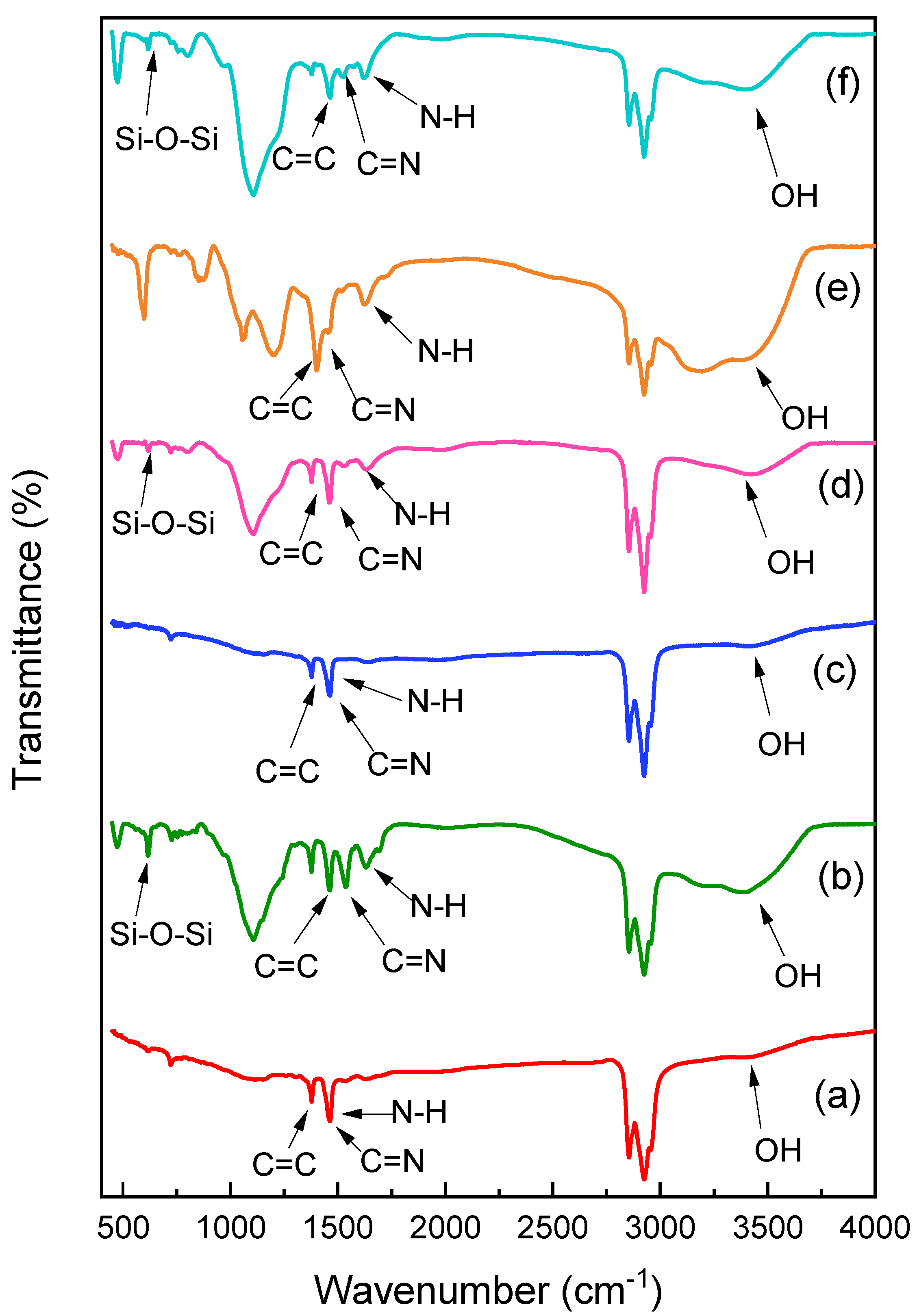
3.1.2. XRD Studies
3.1.3. SEM and EDX Studies
3.1.4. XPS Studies
3.2. Adsorption Studies
3.3. Optimization of Various Parameters
3.3.1. Effect of PH
3.3.2. Effect of Adsorbent Dosage
3.3.3. Contact Time
3.3.4. Temperature
3.3.5. Effect of Ionic Strength
3.4. Kinetic Study
3.5. Thermodynamic Parameters of AR1 and CV Dye Adsorption on the GG-PoPD-Grafted SiO2 Composite
3.6. Adsorption Isotherms for AR1 and CV Dyes Uptake by the GG-PoPD-Grafted SiO2 Composite
3.7. Comparison with Other Adsorbents
3.8. Application of the GG-PoPD-Grafted SiO2 Composite for the Removal of Dyes from Real Water Samples
3.9. Recycling Tests
4. Conclusions
Funding
Institutional Review Board Statement
Data Availability Statement
Conflicts of Interest
References
- Machado, V.; Marinho, A.; de Castro, P.V.; Silva, T. From Fabric to Finish: The Cytotoxic Impact of Textile Chemicals on Humans Health. Textiles 2025, 5, 16. [Google Scholar] [CrossRef]
- Parida, S.; Mandal, A.K.; Behera, A.K.; Patra, S.; Nayak, R.; Behera, C.; Jena, M. A comprehensive review on phycoremediation of azo dye to combat industrial wastewater pollution. J. Water Process. Eng. 2025, 70, 107088. [Google Scholar] [CrossRef]
- Hussain, I.; Majeed, A.; Al-Rawi, S.S.; Ibrahim, A.H.; Iqbal, M.A.; Hanif, A.; Asad, M.; Ahmad, F.; Shahzadi, A.; Haider, M.T. From Wastewater to Sustainability: Tackling Heavy Metal Contamination in Agriculture with Conventional and AI Techniques. Chem. Afr. 2025, 8, 1743–1762. [Google Scholar] [CrossRef]
- Tyagi, S.; Kapoor, R.T.; Singh, R.; Shah, M.P. Insights on microbial enzymes mediated biodegradation of azo dyes: A sustainable strategy for environment clean up. Bioremediat. J. 2025, 1–43. [Google Scholar] [CrossRef]
- Ayyadurai, P.; Ragavendran, C. Green nanotechnologies for removing cosmetic pollutants: Approach towards preserving and protecting aquatic health. Nanotechnol. Environ. Eng. 2025, 10, 21. [Google Scholar] [CrossRef]
- Alzahrani, H.K.; Katowah, D.F. Fabrication of network nanocomposite of polyaniline coating chitosan-graphene oxide-functionalized carbon nanotube and its efficacy in removing dyes from aqueous solution. Nanocomposites 2023, 9, 183–202. [Google Scholar] [CrossRef]
- Fabryanty, R.; Valencia, C.; Soetaredjo, F.E.; Putro, J.N.; Santoso, S.P.; Kurniawan, A.; Ju, Y.-H.; Ismadji, S. Removal of crystal violet dye by adsorption using bentonite—Alginate composite. J. Environ. Chem. Eng. 2017, 5, 5677–5687. [Google Scholar] [CrossRef]
- Ji, Z.; Wang, J.; Yan, Z.; Liu, B.; Liu, Z.; Chang, H.; Liang, H. Integrated oxidation and membrane processes for produced water treatment: An overview and challenges. Sep. Purif. Technol. 2024, 351, 128124. [Google Scholar] [CrossRef]
- Ahmed, S.F.; Islam, N.; Tasannum, N.; Mehjabin, A.; Momtahin, A.; Chowdhury, A.A.; Almomani, F.; Mofijur, M. Microplastic removal and management strategies for wastewater treatment plants. Chemosphere 2023, 347, 140648. [Google Scholar] [CrossRef]
- Dehghani, M.H.; Ahmadi, S.; Ghosh, S.; Othmani, A.; Osagie, C.; Meskini, M.; AlKafaas, S.S.; Malloum, A.; Khanday, W.A.; Jacob, A.O.; et al. Recent advances on sustainable adsorbents for the remediation of noxious pollutants from water and wastewater: A critical review. Arab. J. Chem. 2023, 16, 105303. [Google Scholar] [CrossRef]
- Strebel, A.; Behringer, M.; Hilbig, H.; Machner, A.; Helmreich, B. Anionic azo dyes and their removal from textile wastewater through adsorption by various adsorbents: A critical review. Front. Environ. Eng. 2024, 3, 1347981. [Google Scholar] [CrossRef]
- Alqarni, S.A. Green synthesis of cross-linked polyamine folic acid–Fe3O4@SiO2-NH2 nanocomposites and their efficacy for removing dyes from aqueous solutions. Compos. Interfaces 2025, 1–22. [Google Scholar] [CrossRef]
- Saleh, S.; Salama, A.; Awad, O.M.; De Santis, R.; Guarino, V.; Tolba, E. Polyamide Electrospun Nanofibers Functionalized with Silica and Titanium Dioxide Nanoparticles for Efficient Dye Removal. J. Compos. Sci. 2024, 8, 59. [Google Scholar] [CrossRef]
- Gharbi, A.H.; Hemmami, H.; Laouini, S.E.; Bouafia, A.; Ben Amor, I.; Zeghoud, S.; Gherbi, M.T.; Ben Amor, A.; Alharthi, F.; Abdullah, J.A.A. Novel CuO–SiO2 nanocomposites: Synthesis, kinetics, recyclability, high stability and photocatalytic efficiency for Rose Bengal dye removal. Transit. Met. Chem. 2024, 49, 195–213. [Google Scholar] [CrossRef]
- Alqarni, S.A. Deliberated system of ternary core–shell polythiophene/ZnO/MWCNTs and polythiophene/ZnO/ox-MWCNTs nanocomposites for brilliant green dye removal from aqueous solutions. Nanocomposites 2022, 8, 47–63. [Google Scholar] [CrossRef]
- Alqarni, S.A. The Performance of Different AgTiO2 Loading into Poly(3-Nitrothiophene) for Efficient Adsorption of Hazardous Brilliant Green and Crystal Violet Dyes. Int. J. Polym. Sci. 2022, 2022, 4691347. [Google Scholar] [CrossRef]
- Mayet, A.M.; Hijji, M.; Saleh, E.A.M.; Reza, A.; Kadhim, S.I.; Abdullaev, S.S.; Alsalamy, A.; Hassan, Z.F.; Gomez, C.V.; Tene, T. The Role of Biocomposites and Nanocomposites in Eliminating Organic Contaminants from Effluents. Water 2023, 15, 3093. [Google Scholar] [CrossRef]
- Rostamabadi, H.; Demirkesen, I.; Colussi, R.; Roy, S.; Tabassum, N.; Filho, J.G.D.O.; Bist, Y.; Kumar, Y.; Nowacka, M.; Galus, S.; et al. Recent trends in the application of films and coatings based on starch, cellulose, chitin, chitosan, xanthan, gellan, pullulan, Arabic gum, alginate, pectin, and carrageenan in food packaging. Food Front. 2024, 5, 350–391. [Google Scholar] [CrossRef]
- Lefatle, M.C.; Madikizela, L.M.; Pakade, V.E.; Nomngongo, P.N. Magnetic chitosan-zeolite composite as an adsorbent in ultrasound-assisted magnetic solid phase extraction of tetracyclines in water samples. J. Anal. Sci. Technol. 2023, 14, 28. [Google Scholar] [CrossRef]
- Kumar, S.; Bera, R.; Das, N.; Koh, J. Chitosan-based zeolite-Y and ZSM-5 porous biocomposites for H2 and CO2 storage. Carbohydr. Polym. 2020, 232, 115808. [Google Scholar] [CrossRef]
- Ibrahim, H.K.; Abdulridha, A.A.; Allah, M.A.A.H. Glutaraldehyde and terephthaldehyde-crosslinked chitosan for cationic and anionic dyes removal from aqueous solutions: Experimental, DFT, kinetic and thermodynamic studies. Int. J. Biol. Macromol. 2024, 262, 129730. [Google Scholar] [CrossRef]
- Polesca, C.; Passos, H.; Nakasu, P.Y.S.; Coutinho, J.A.P.; Freire, M.G.; Hallett, J.P. Ionic-liquid-processed keratin-based biocomposite films with cellulose and chitin for sustainable dye removal. RSC Sustain. 2024, 2, 2239–2248. [Google Scholar] [CrossRef]
- Li, X.; Xu, L.; Gao, J.; Yan, M.; Bi, H.; Wang, Q. Surface modification of chitin nanofibers with dopamine as efficient nanosorbents for enhanced removal of dye pollution and metal ions. Int. J. Biol. Macromol. 2023, 253, 127113. [Google Scholar] [CrossRef]
- Jalili, M.; Meftahizade, H.; Golafshan, A.; Zamani, E.; Zamani, M.; Moghaddam, N.B.; Ghorbanpour, M. Green synthesized guar plant composites for wastewater remediation: A comprehensive review. Polym. Bull. 2023, 81, 247–273. [Google Scholar] [CrossRef]
- Sharma, R.; Kaith, B.S.; Kalia, S.; Pathania, D.; Kumar, A.; Sharma, N.; Street, R.M.; Schauer, C. Biodegradable and conducting hydrogels based on Guar gum polysaccharide for antibacterial and dye removal applications. J. Environ. Manag. 2015, 162, 37–45. [Google Scholar] [CrossRef]
- Malviya, R.; Singh, A.K. Graft Copolymers of Polysaccharide: Synthesis Methodology and Biomedical Applications in Tissue Engineering. Curr. Pharm. Biotechnol. 2023, 24, 510–531. [Google Scholar] [CrossRef]
- Moradi, A.; Kalaee, M.; Moradi, O.; Mahmoodi, N.M.; Zaarei, D. Surface coated Guar gum biocomposite (Zeolite imidazolate framework (ZIF-8)-Guar gum–Polyvinylpyrrolidone) as an environmentally friendly adsorbent: Preparation, isotherm and kinetics of pollutant removal. J. Mol. Struct. 2024, 1304, 137642. [Google Scholar] [CrossRef]
- Tyagi, R.; Dangi, D.; Sharma, P. Optimization of Hazardous Malachite Green Dye Removal Process Using Double Derivatized Guar Gum Polymer: A Fractional Factorial L9 Approach. Sustain. Chem. Clim. Action 2024, 100043. [Google Scholar] [CrossRef]
- Chopra, L.; Sharma, A.; Chohan, J.S.; Upadhyay, V.V.; Singh, R.; Sharma, S.; Dwivedi, S.P.; Kumar, A.; Tag-Eldin, E.M. Synthesis and characterizations of super adsorbent hydrogel based on biopolymer, Guar Gum-grafted-Poly (hydroxyethyl methacrylate) (Gg-g-Poly (HEMA)) for the removal of Bismarck brown Y dye from aqueous solution. Int. J. Biol. Macromol. 2023, 256, 128518. [Google Scholar] [CrossRef]
- Aziz, K.; El Achaby, M.; Jacquemin, J.; Kurniawan, T.A.; Aziz, F. A composite based on hydroxyapatite biocrystal and poly(aniline-o-phenylenediamine) copolymer for efficient removal of anionic dyes from wastewater. J. Taiwan Inst. Chem. Eng. 2023, 166, 105256. [Google Scholar] [CrossRef]
- Meng, Y.; Xiao, L.; Muslim, A.; Hojiahmat, M. Improving the adsorption of poly(o-phenylenediamine) to heavy metal ions in aqueous solution through its composite with carbon dots. J. Polym. Res. 2021, 28, 404. [Google Scholar] [CrossRef]
- Santos, N.A.V.; Pulido, M.T.R.; Tumacder, D.V.C.; Taaca, K.L.M. Effect of polyaniline on the structural, conductivity, and dielectric properties of chitosan. Carbohydr. Polym. Technol. Appl. 2021, 2, 100129. [Google Scholar] [CrossRef]
- Dubey, R.; Rajesh, Y.; More, M. Synthesis and Characterization of SiO2 Nanoparticles via Sol-gel Method for Industrial Applications. Mater. Today: Proc. 2015, 2, 3575–3579. [Google Scholar] [CrossRef]
- Marczenko, Z. Separation and spectrophotometric determination of elements; E. Horwood: Chichester, UK; Halsted Press: New York, NY, USA, 1976. [Google Scholar]
- Ćirić-Marjanović, G.; Trchová, M.; Konyushenko, E.N.; Holler, P.; Stejskal, J. Chemical Oxidative Polymerization of Aminodiphenylamines. J. Phys. Chem. B 2008, 112, 6976–6987. [Google Scholar] [CrossRef]
- Sankar, S.; Sharma, S.K.; Kaur, N.; Lee, B.; Kim, D.Y.; Lee, S.; Jung, H. Biogenerated silica nanoparticles synthesized from sticky, red, and brown rice husk ashes by a chemical method. Ceram. Int. 2016, 42, 4875–4885. [Google Scholar] [CrossRef]
- Peerzada, J.G.; Chidambaram, R. A Statistical Approach for Biogenic Synthesis of Nano-Silica from Different Agro-Wastes. Silicon 2020, 13, 2089–2101. [Google Scholar] [CrossRef]
- Muzzarelli, R.A.; Morganti, P.; Morganti, G.; Palombo, P.; Palombo, M.; Biagini, G.; Belmonte, M.M.; Giantomassi, F.; Orlandi, F.; Muzzarelli, C. Chitin nanofibrils/chitosan glycolate composites as wound medicaments. Carbohydr. Polym. 2007, 70, 274–284. [Google Scholar] [CrossRef]
- Shankar, S.; Reddy, J.P.; Rhim, J.-W.; Kim, H.-Y. Preparation, characterization, and antimicrobial activity of chitin nanofibrils reinforced carrageenan nanocomposite films. Carbohydr. Polym. 2015, 117, 468–475. [Google Scholar] [CrossRef]
- Yen, M.-T.; Yang, J.-H.; Mau, J.-L. Physicochemical characterization of chitin and chitosan from crab shells. Carbohydr. Polym. 2009, 75, 15–21. [Google Scholar] [CrossRef]
- Gong, Y.; Yu, Y.; Kang, H.; Chen, X.; Liu, H.; Zhang, Y.; Sun, Y.; Song, H. Synthesis and Characterization of Graphene Oxide/Chitosan Composite Aerogels with High Mechanical Performance. Polymers 2019, 11, 777. [Google Scholar] [CrossRef]
- Abukhadra, M.R.; Saad, I.; Othman, S.I.; Katowah, D.F.; Ajarem, J.S.; Alqarni, S.A.; Allam, A.A.; Al Zoubi, W.; Ko, Y.G. Characterization of Fe0@Chitosan/Cellulose structure as effective green adsorbent for methyl Parathion, malachite Green, and levofloxacin Removal: Experimental and theoretical studies. J. Mol. Liq. 2022, 368, 120730. [Google Scholar] [CrossRef]
- Gihar, S.; Kumar, D.; Kumar, P. Facile synthesis of novel pH-sensitive grafted guar gum for effective removal of mercury (II) ions from aqueous solution. Carbohydr. Polym. Technol. Appl. 2021, 2, 100110. [Google Scholar] [CrossRef]
- El Batouti, M.; Sadik, W.; Eldemerdash, A.G.; Hanafy, E.; Fetouh, H.A. New and innovative microwave-assisted technology for synthesis of guar gum-grafted acrylamide hydrogel superabsorbent for the removal of acid red 8 dye from industrial wastewater. Polym. Bull. 2022, 80, 4965–4989. [Google Scholar] [CrossRef]
- Khelifa, I.; Belmokhtar, A.; Berenguer, R.; Benyoucef, A.; Morallon, E. New poly(o-phenylenediamine)/modified-clay nanocomposites: A study on spectral, thermal, morphological and electrochemical characteristics. J. Mol. Struct. 2019, 1178, 327–332. [Google Scholar] [CrossRef]
- Tejedor, J.; Guerrero, V.H.; Vizuete, K.; Debut, A. Environmentally friendly synthesis of silicon dioxide nanoparticles and their application for the removal of emerging contaminants in aqueous media. J. Phys. Conf. Ser. 2022, 2238, 012005. [Google Scholar]
- Mondal, T.; Ashkar, R.; Butler, P.; Bhowmick, A.K.; Krishnamoorti, R. Graphene Nanocomposites with High Molecular Weight Poly(ε-caprolactone) Grafts: Controlled Synthesis and Accelerated Crystallization. ACS Macro Lett. 2016, 5, 278–282. [Google Scholar] [CrossRef]
- Li, X.; Xing, Y.; Jiang, Y.; Ding, Y.; Li, W. Antimicrobial activities of ZnO powder-coated PVC film to inactivate food pathogens. Int. J. Food Sci. Technol. 2009, 44, 2161–2168. [Google Scholar] [CrossRef]
- Heiba, H.F.; Taha, A.A.; Mostafa, A.R.; Mohamed, L.A.; Fahmy, M.A. Preparation and characterization of novel mesoporous chitin blended MoO3-montmorillonite nanocomposite for Cu(II) and Pb(II) immobilization. Int. J. Biol. Macromol. 2020, 152, 554–566. [Google Scholar] [CrossRef]
- Wang, T.; Sun, H.; Peng, T.; Liu, B.; Hou, Y.; Lei, B. Preparation and characterization of polyaniline/p-phenylenediamine grafted graphene oxide composites for supercapacitors. J. Mol. Struct. 2020, 1221, 128835. [Google Scholar] [CrossRef]
- Kiran, J.U.; Roners, J.P.; Mathew, S. XPS and thermal studies of silver doped SiO2 matrices for plasmonic applications. Mater. Today: Proc. 2020, 33, 1263–1267. [Google Scholar] [CrossRef]
- Katowah, D.F.; Abdel-Fadeel, M.A. Ultrahigh adsorption capacity of a new metal sieve-like structure nanocomposite-based chitosan-graphene oxide nanosheet coated with poly-o-toluidine for the removal of Acid Red dye from the aquatic environment. Nanocomposites 2023, 9, 80–99. [Google Scholar] [CrossRef]
- Obaid, A.O.; Al Zbedy, A.S.; Alrashdi, K.S.; Aljohani, M.M.; Alqarni, S.A.; Al-Bonayan, A.M.; Abumelha, H.M.; El-Metwaly, N.M. Mercury capture using functionalized metal-organic framework encapsulated in dual hydrogel layers of β-cyclodextrin and polyethylenimine: Synthesis, characterization, adsorption, thermodynamics, and Box–Behnken design analysis. Carbohydr. Polym. Technol. Appl. 2025, 10, 100793. [Google Scholar] [CrossRef]
- Katowah, D.F.; Alzahrani, H.K. A new ternary nanocomposites-based cellulose derivatives-CuFe2O4-zeolite with ultra-high adsorption capacity for Brilliant Green dye treatment and removal from the aquatic environment. J. Saudi Chem. Soc. 2023, 27, 101764. [Google Scholar] [CrossRef]
- Gabal, M.A.; Al-Harthy, E.A.; Al Angari, Y.M.; Salam, M.A.; Awad, A.; Al-Juaid, A.A.; Saeed, A. Synthesis, Characterization and Dye Removal Capability of Conducting Polypyrrole/Mn0.8Zn0.2Fe2O4/Graphite Oxide Ternary Composites. Catalysts 2022, 12, 1624. [Google Scholar] [CrossRef]
- Nag, S.; Ghosh, A.; Das, D.; Mondal, A.; Mukherjee, S. Ni0.5Zn0.5Fe2O4/polypyrrole nanocomposite: A novel magnetic photocatalyst for degradation of organic dyes. Synth. Met. 2020, 267, 116459. [Google Scholar] [CrossRef]
- Alzahrani, S.O.; Alqarni, S.A.; Alessa, H.; Ashour, G.R.; Jawhari, A.H.; Hameed, A.; Al-Bonayan, A.M.; El-Metwaly, N.M. Electrospun nanofibers membrane of carbon quantum dots loaded onto chitosan-polyvinyl alcohol for removal of rhodamine B dye from aqueous solutions: Adsorption isotherm, kinetics, thermodynamics and optimization via Box-Behnken design. Int. J. Biol. Macromol. 2025, 304, 140951. [Google Scholar] [CrossRef]
- Al-Saidi, H.M.; Abdel-Fadeel, M.A.; Alharthi, S.S. Preconcentration and ultrasensitive spectrophotometric estimation of tungsten in soils using polyurethane foam in the presence of rhodamine B: Kinetic and thermodynamic studies, and designing a simple automated preconcentration system. J. Saudi Chem. Soc. 2021, 25, 101301. [Google Scholar] [CrossRef]
- Alqarni, S.A.; Ashour, G.R.S.; Alhasani, M.; Halawani, N.M.; Alenazy, D.M.; Aljohani, M.M.; Alharbi, M.M.; El-Metwaly, N.M. ZIFs-MOF Anchored Amberlite Polymer for Uses as an Adsorbent in a Hemodialysis. J. Inorg. Organomet. Polym. Mater. 2024, 35, 3143–3157. [Google Scholar] [CrossRef]
- Langmuir, I. The adsorption of gases on plane surfaces of glass, mica and platinum. J. Am. Chem. Soc. 1918, 40, 1361–1403. [Google Scholar] [CrossRef]
- Sacco, O.; Matarangolo, M.; Vaiano, V.; Libralato, G.; Guida, M.; Lofrano, G.; Carotenuto, M. Crystal violet and toxicity removal by adsorption and simultaneous photocatalysis in a continuous flow micro-reactor. Sci. Total. Environ. 2018, 644, 430–438. [Google Scholar] [CrossRef]
- Sidjou, A.S.; Tchakounte, A.N.; Shikuku, V.; Lenou, I.; Djimtibaye, R.; Dika, M.M. Synthesis of alkali-activated volcanic scoria and rice husk ash based composite materials for adsorptive removal of crystal violet: Optimization, kinetics, isotherms and mechanism. Hybrid Adv. 2023, 4, 100113. [Google Scholar] [CrossRef]
- Abdel-Fadeel, M.A.; Aljohani, N.S.; Al-Mhyawi, S.R.; Halawani, R.F.; Aljuhani, E.H.; Salam, M.A. A simple method for removal of toxic dyes such as Brilliant Green and Acid Red from the aquatic environment using Halloysite nanoclay. J. Saudi Chem. Soc. 2022, 26, 101475. [Google Scholar] [CrossRef]
- Alizadeh, S.; Seyyedi, K. Removal of C.I. Acid red 1 (AR1) Dye Pollutant from Contaminated Waters by Adsorption Method using Sunflower Seed Shells and Pine cone as Agro-waste Materials. J. Appl. Chem. Res. 2019, 13, 93–105. [Google Scholar]
- Ashour, M.; Alprol, A.E.; Khedawy, M.; Abualnaja, K.M.; Mansour, A.T. Equilibrium and Kinetic Modeling of Crystal Violet Dye Adsorption by a Marine Diatom, Skeletonema costatum. Materials 2022, 15, 6375. [Google Scholar] [CrossRef]
- Laskar, N.; Kumar, U. Adsorption of Crystal Violet from Wastewater by Modified Bambusa tulda. KSCE J. Civ. Eng. 2017, 22, 2755–2763. [Google Scholar] [CrossRef]
- Gul, S.; Afsar, S.; Gul, H.; Ali, B. Removal of crystal violet dye from wastewater using low-cost biosorbent Trifolium repens stem powder. J. Iran. Chem. Soc. 2023, 20, 2781–2792. [Google Scholar] [CrossRef]
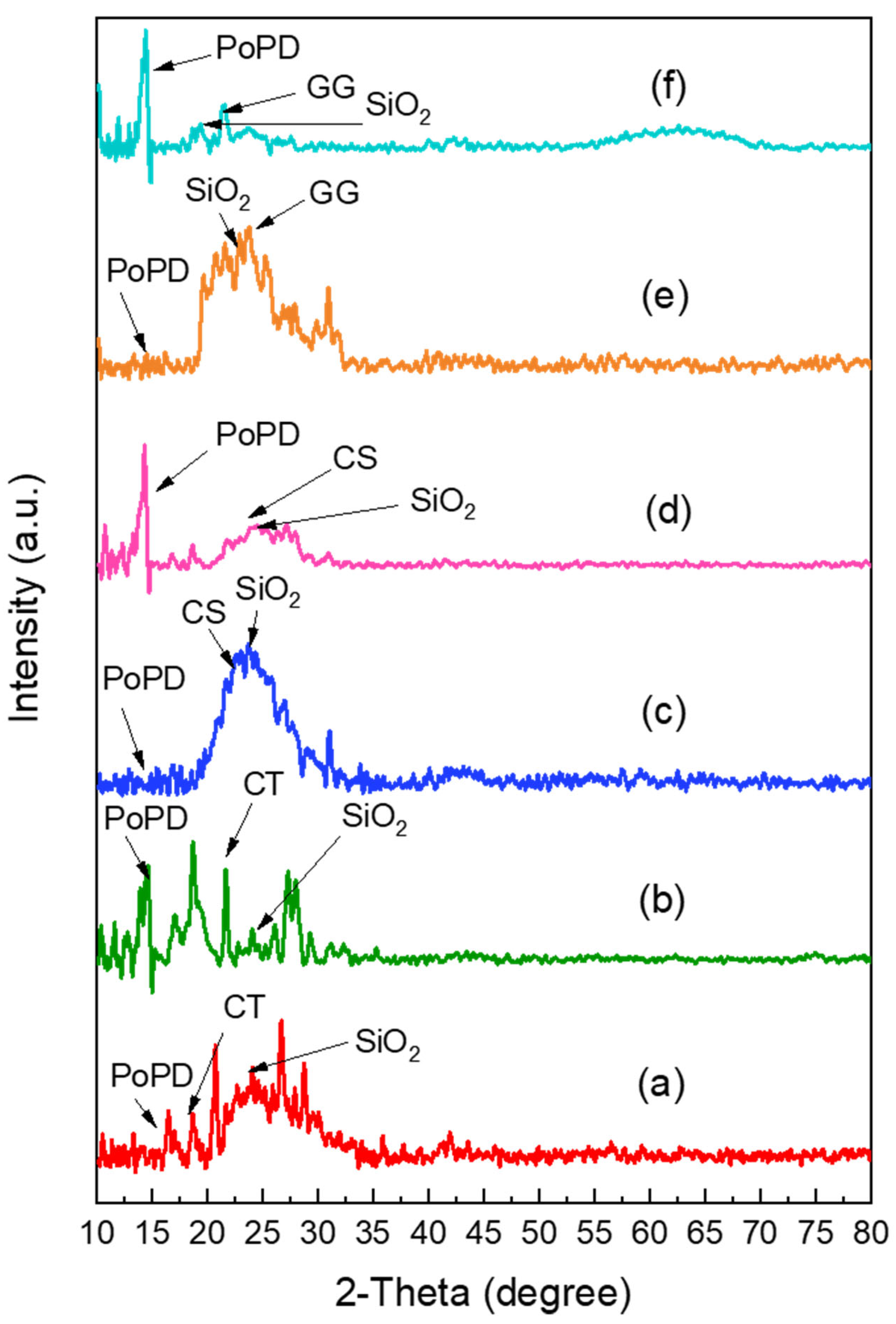
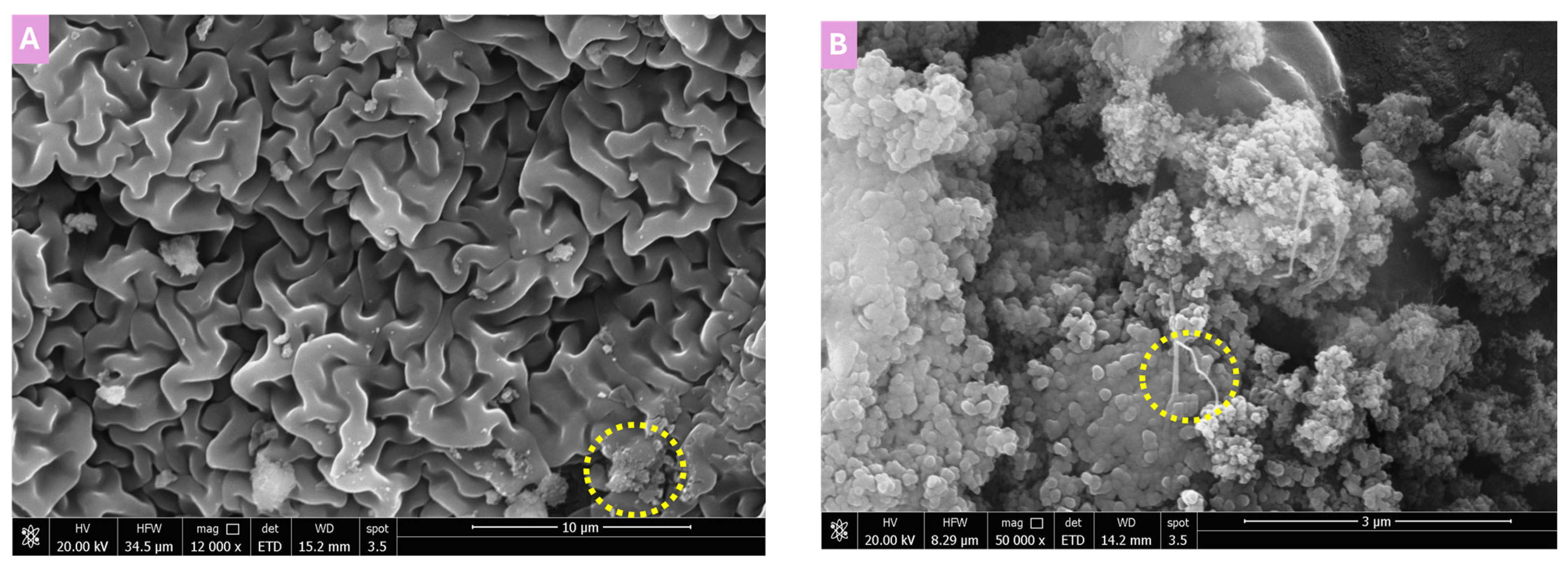
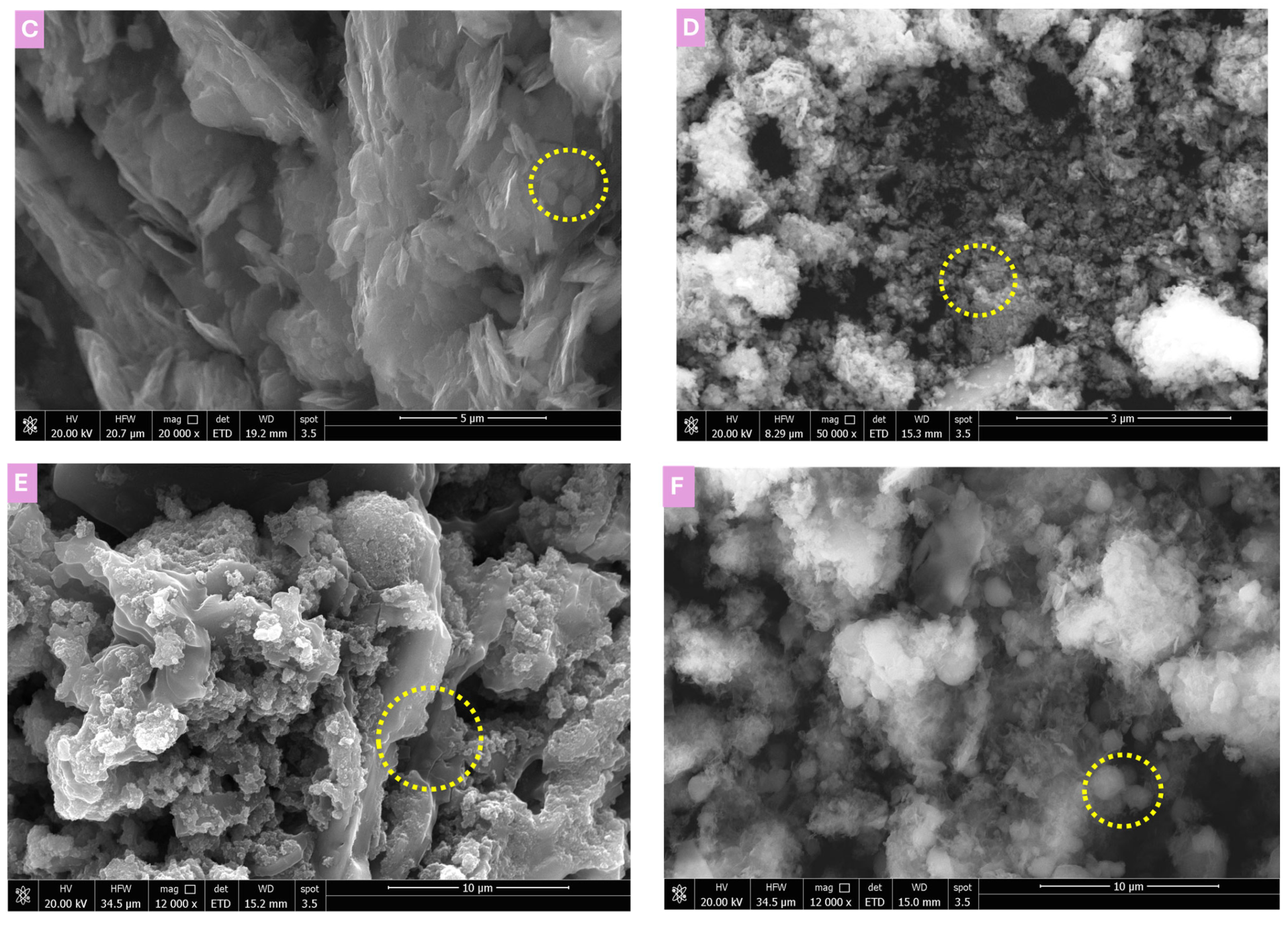
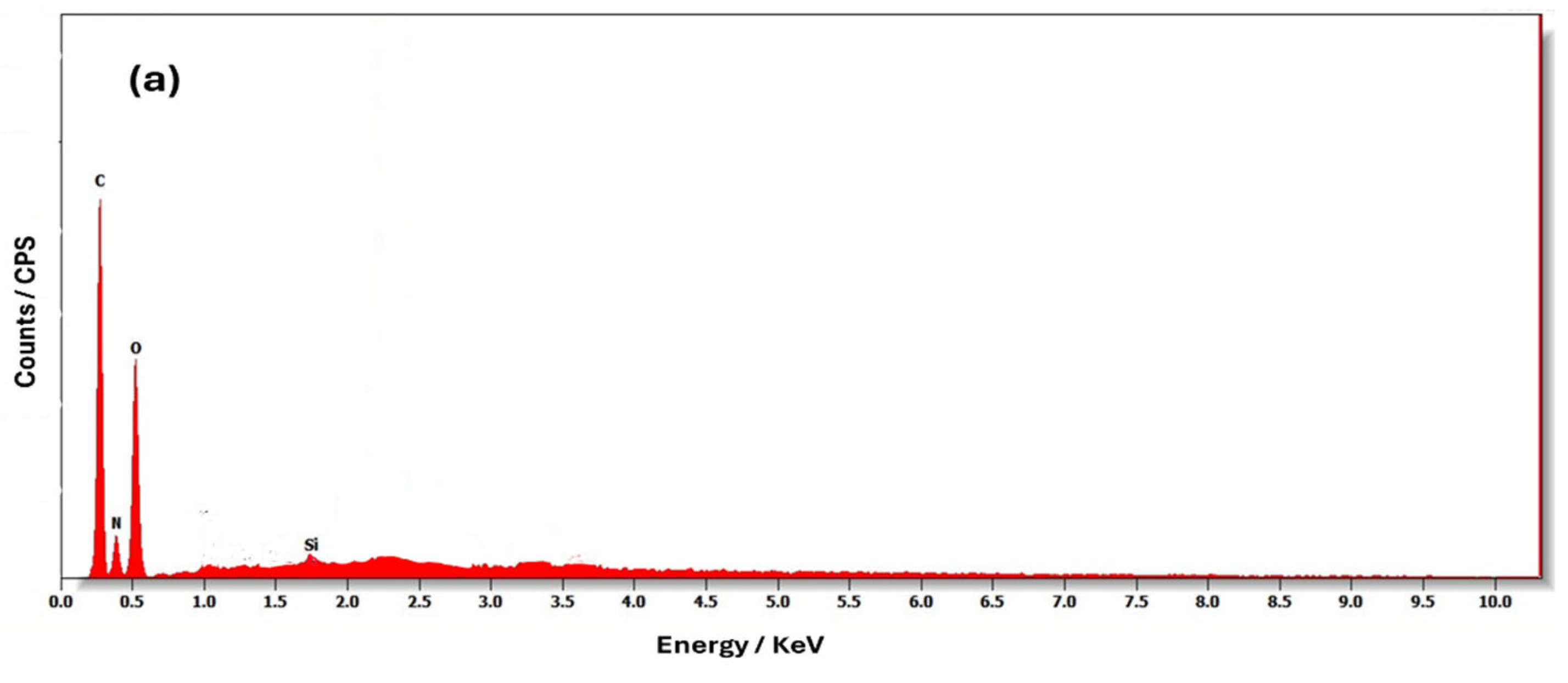

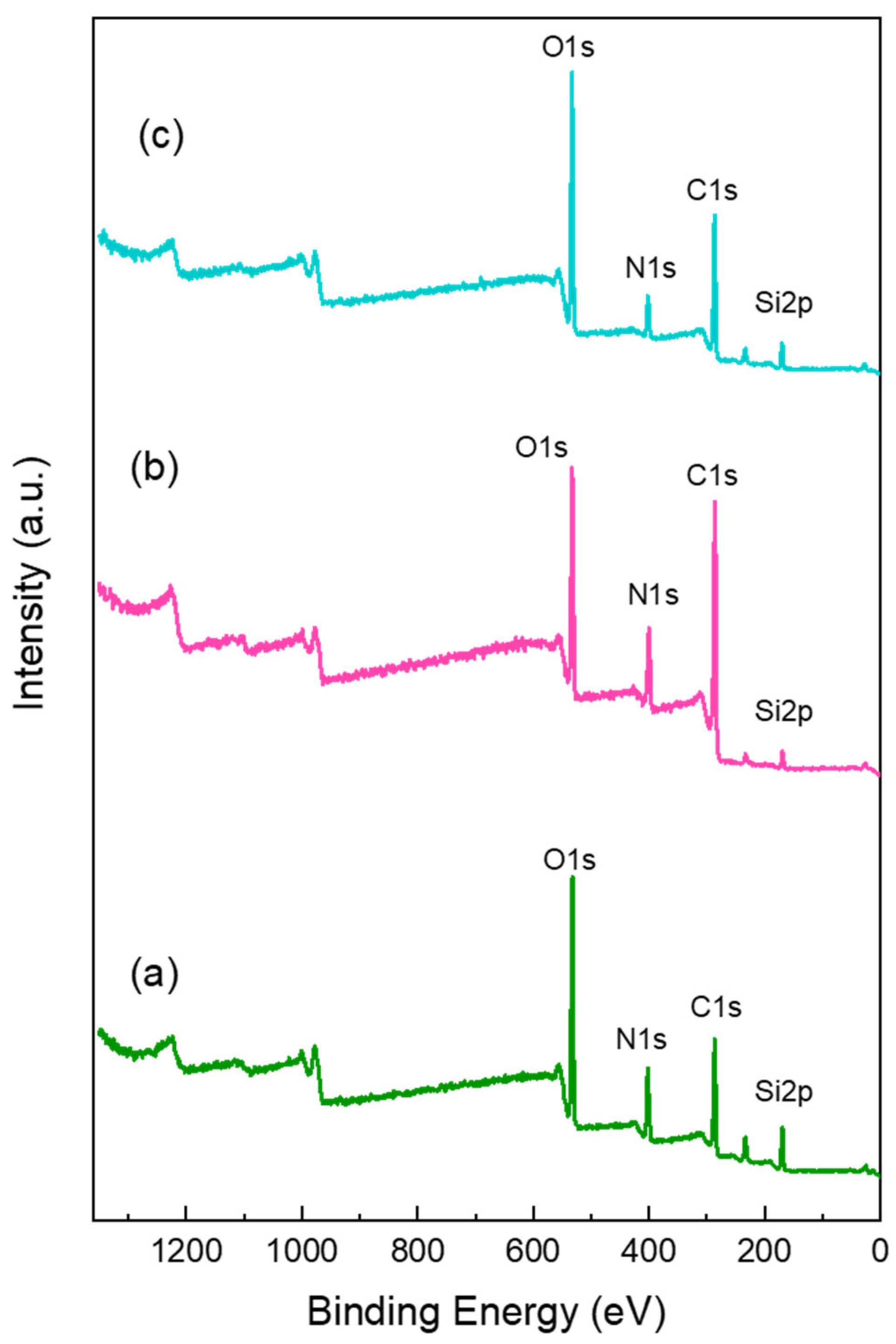
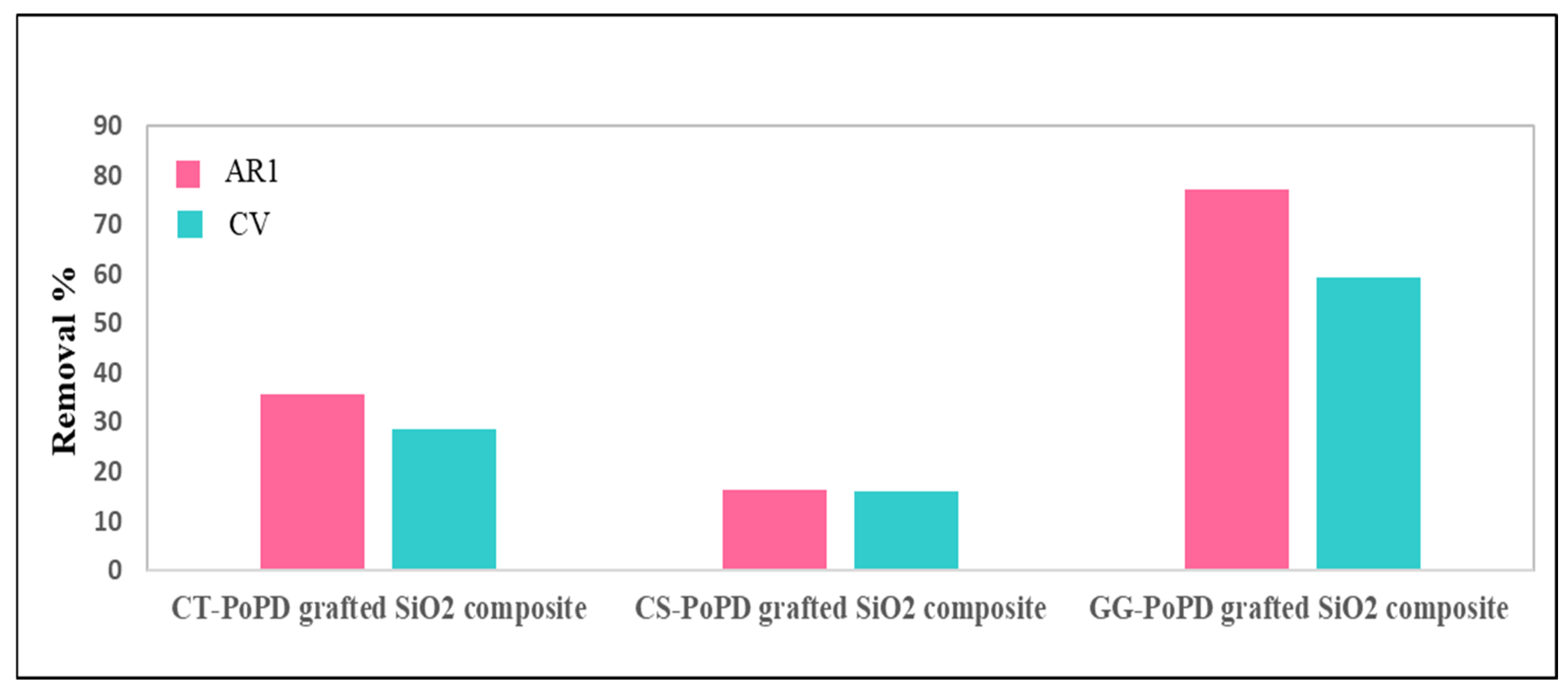
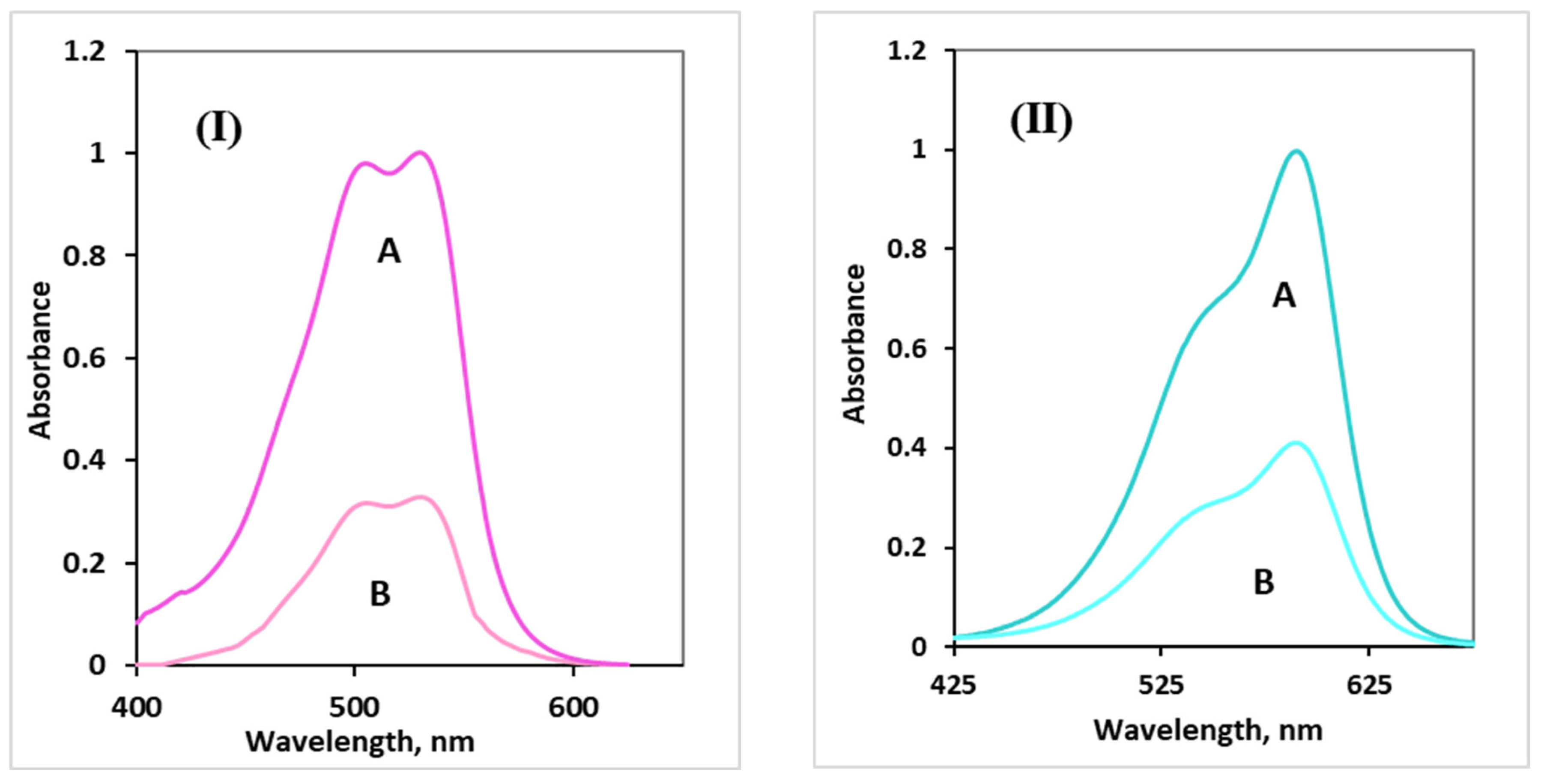
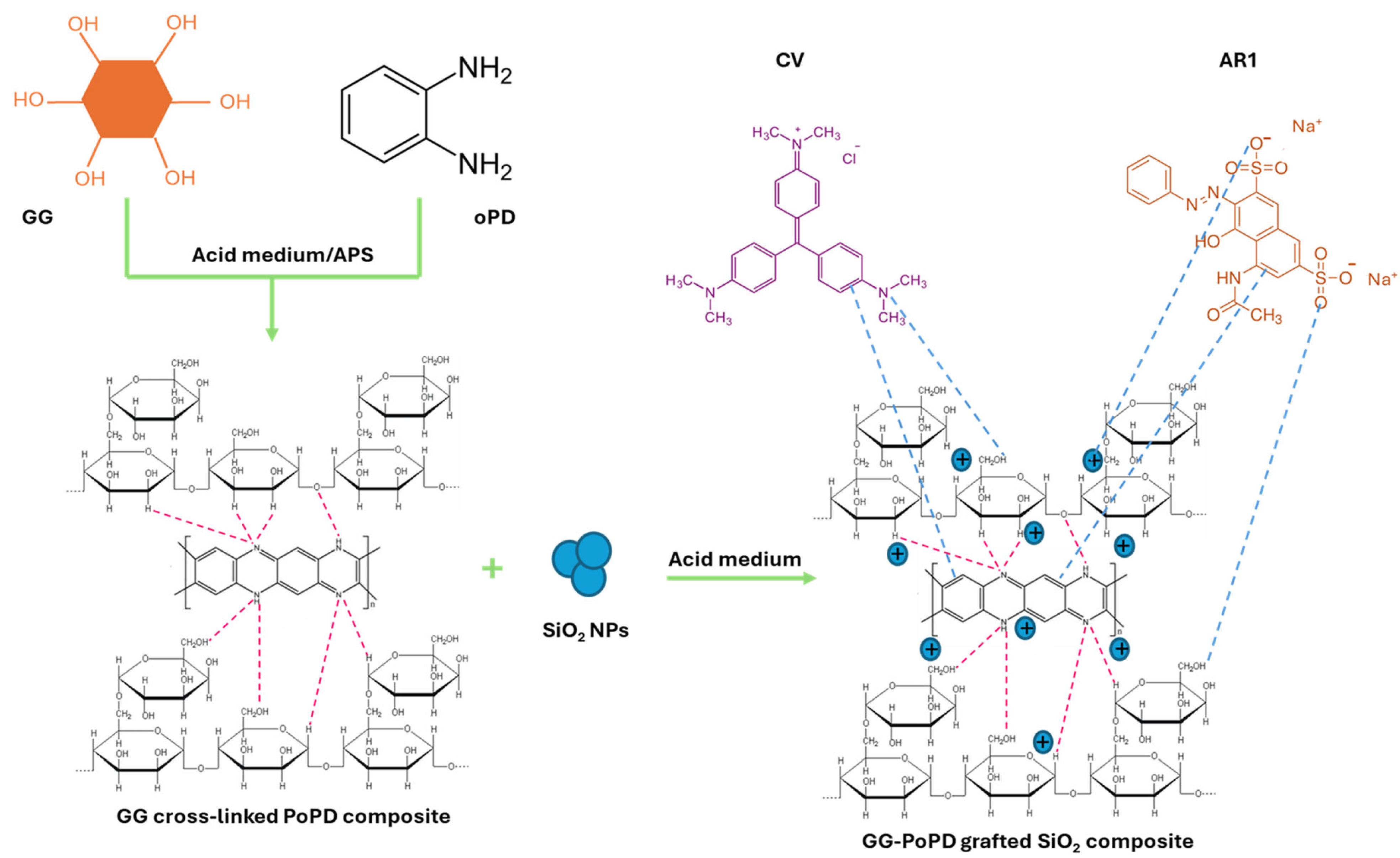

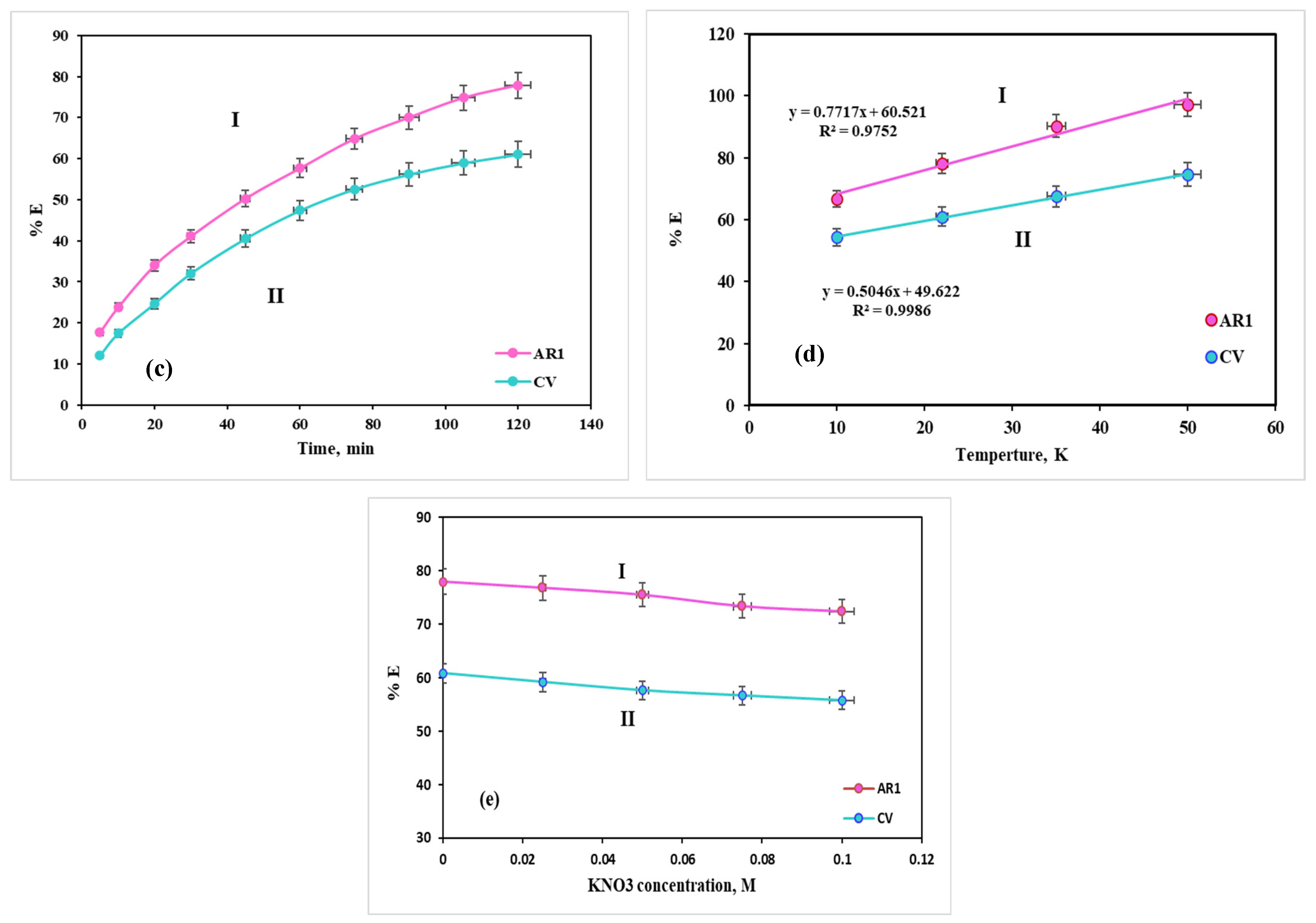
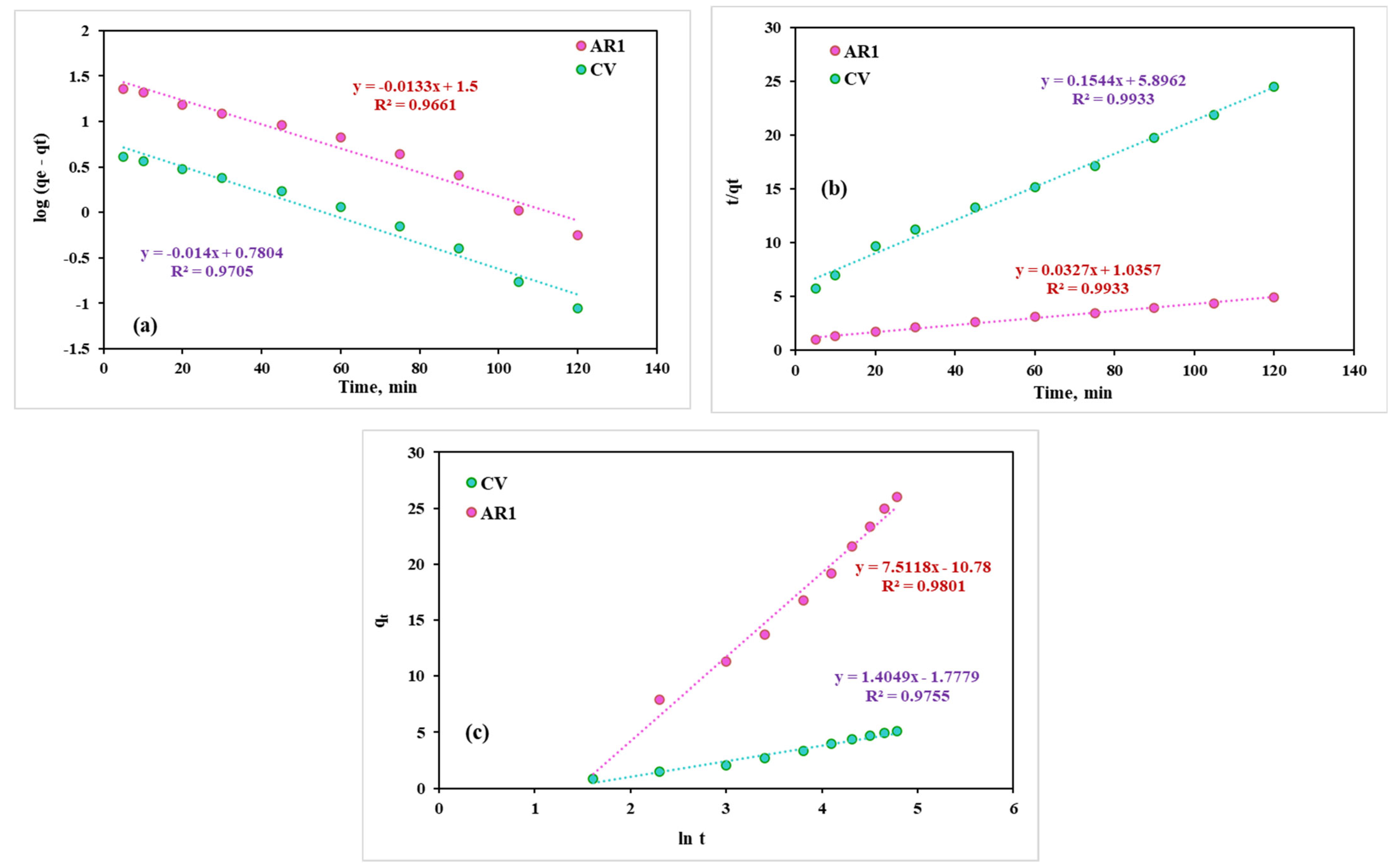
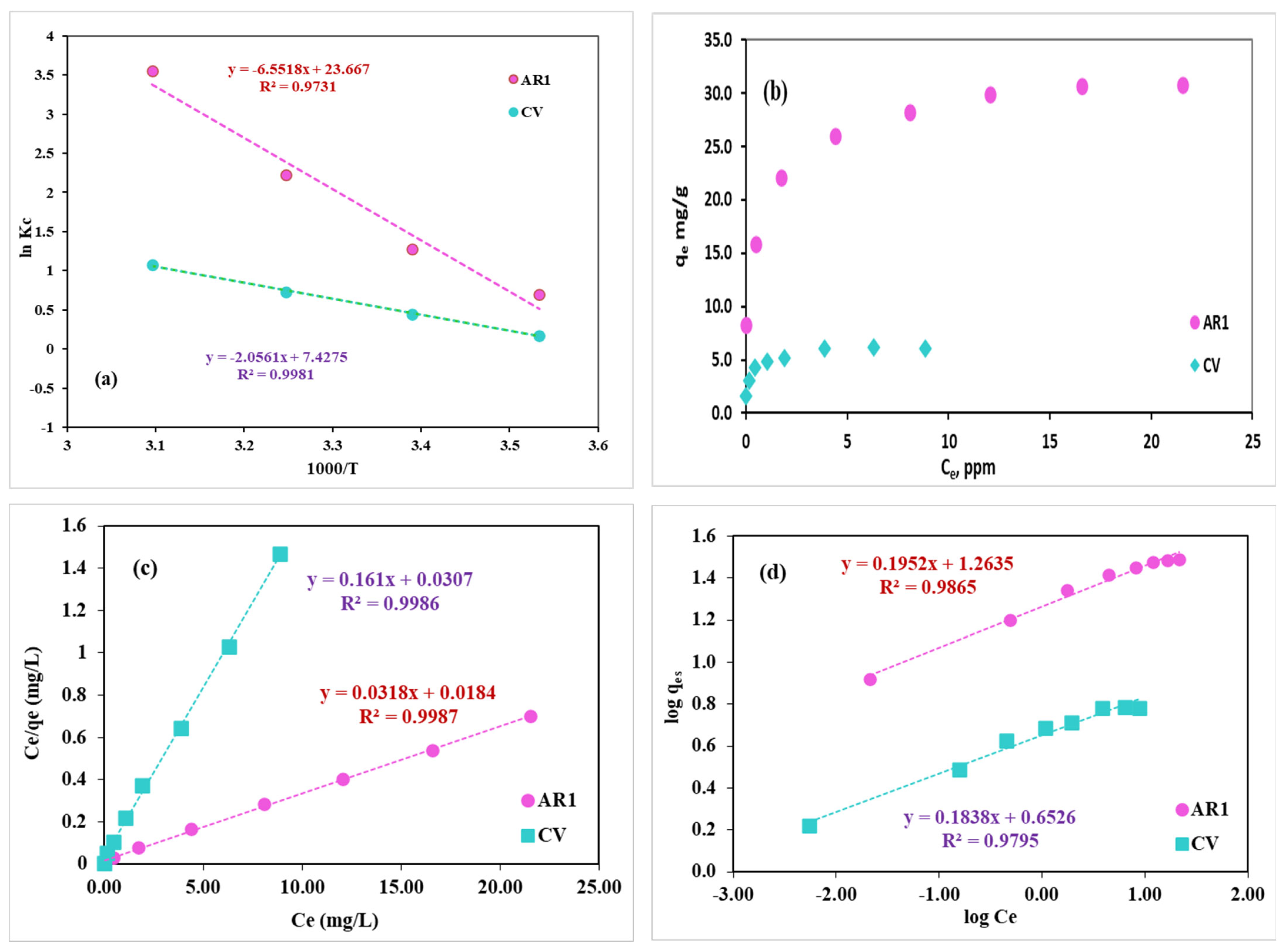
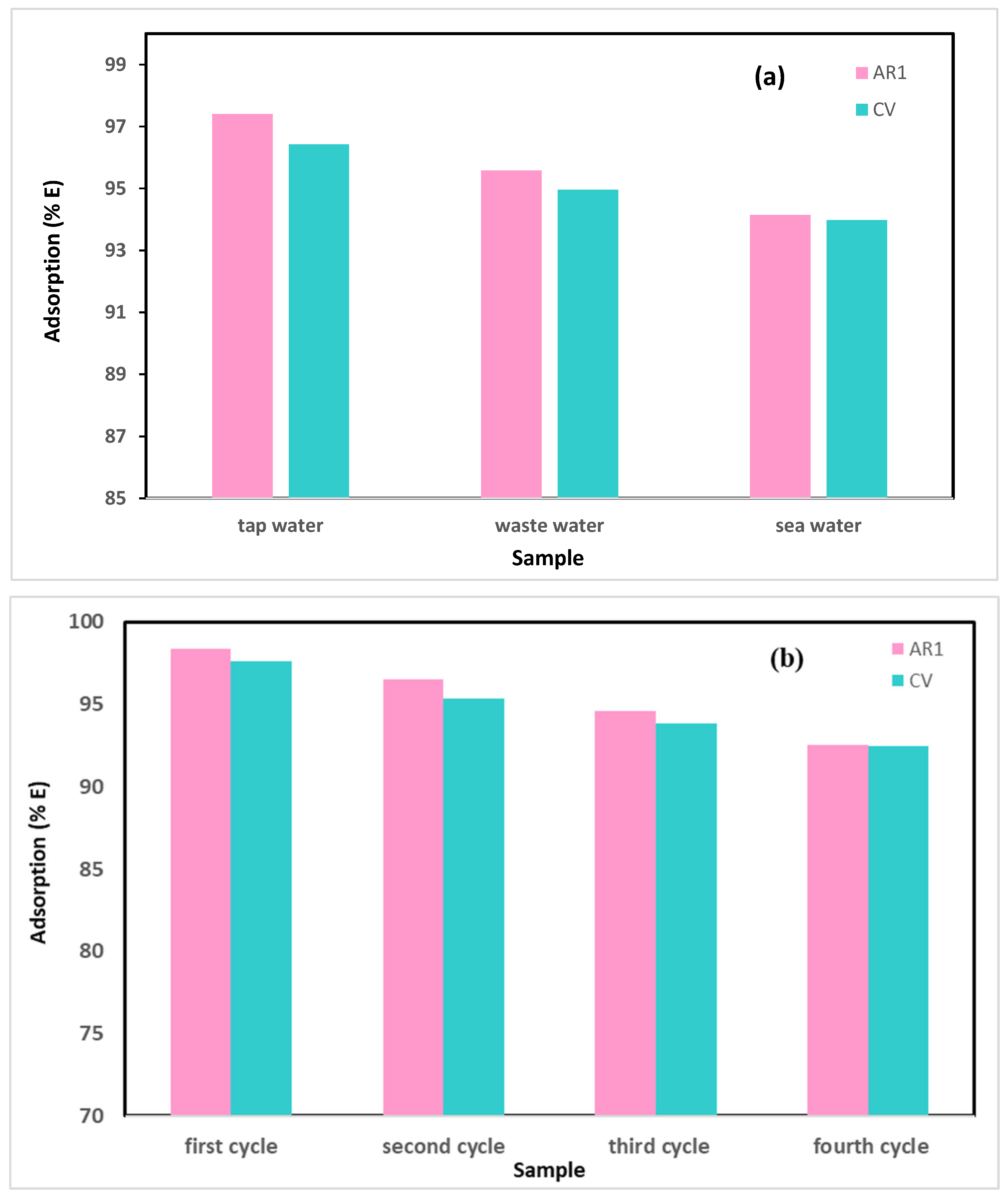
| The Pseudo-First-Order Kinetic (Lagregen) Model | ||||
|---|---|---|---|---|
| qe, exp (mg/g) | qe, calc (mg/g) | k1 | R2 | |
| AR1 | 25.98 | 31.62 | 0.031 | 0.966 |
| CV | 5.089 | 6.029 | 0.032 | 0.971 |
| The Pseudo-Second-Order Kinetic Model | ||||
| qe, exp (mg/g) | qe, calc (mg/g) | k2 | R2 | |
| AR1 | 25.98 | 30.58 | 1.03 × 10−3 | 0.993 |
| CV | 5.089 | 6.47 | 4.0 × 10−3 | 0.993 |
| Elovich Kinetic Model | ||||
| α, (g/mg min) | β, (mg/g min) | R2 | ||
| AR1 | 0.032 | 7.51 | 0.98 | |
| CV | 0.181 | 1.405 | 0.976 | |
| Equations to Calculate the Thermodynamic Parameters | Dye | ΔH (kJ/mol) | ΔS (J/K mol) | ΔG (kJ/mol) |
|---|---|---|---|---|
ΔG = ΔH − TΔS ΔG = RT lnKc | AR1 | 54.47 | 196.7 | −3.556 |
| CV | 17.09 | 61.75 | −1.122 |
| Models of Sorption Isotherms | AR1 Dye | CV Dye | |
|---|---|---|---|
| Langmuir | qm, mg/g | 31.45 | 6.21 |
| KL, L/g | 0.578 | 0.191 | |
| RL | 0.079 | 0.208 | |
| R2 | 0.9987 | 0.9986 | |
| Freundlich | KF, mg/g | 18.32 | 4.89 |
| 1/n | 0.195 | 0.184 | |
| R2 | 0.9865 | 0.9795 | |
| Dye | Adsorbents | Shaking Time (min) | pH | qe calc (mg/g) | Reference |
|---|---|---|---|---|---|
| AR1 | Halloysite nanoclay | 60 | 2 | 13.89 | [63] |
| Sunflower seed shell | 100 | 2 | 6.81 | [64] | |
| Polypyrrole/Mn0.8Zn0.2Fe2O4/Graphite Oxide ternary composites | 60 | 2 | 2.81 | [55] | |
| GG-PoPD-grafted SiO2 composite | 75 | 2 | 30.58 | This Work | |
| CV | a marine diatom alga, Skeletonema costatum | 120 | 3 | 6.41 | [65] |
| Modified Bambusa tulda | 60 | 7 | 4.95 | [66] | |
| biosorbent (white clover: Trifolium repens) stem powder | 140 | 2 | 1.96 | [67] | |
| GG-PoPD-grafted SiO2 composite | 75 | 8 | 6.47 | This Work |
| Sample | Composite, mg | Dye, mg L−1 | Shaken Time, min | PH | Temperature, K | Recovery, (%) | ||||||
|---|---|---|---|---|---|---|---|---|---|---|---|---|
| AR1 | CV | AR1 | CV | AR1 | CV | AR1 | CV | AR1 | CV | AR1 | CV | |
| Tap water | 35 | 35 | 20 | 5 | 120 | 120 | 2 | 8 | 295 | 295 | 97.41 | 96.42 |
| Wastewater | 35 | 35 | 20 | 5 | 120 | 120 | 2 | 8 | 295 | 295 | 95.58 | 94.95 |
| Seawater | 35 | 35 | 20 | 5 | 120 | 120 | 2 | 8 | 295 | 295 | 94.14 | 93.97 |
Disclaimer/Publisher’s Note: The statements, opinions and data contained in all publications are solely those of the individual author(s) and contributor(s) and not of MDPI and/or the editor(s). MDPI and/or the editor(s) disclaim responsibility for any injury to people or property resulting from any ideas, methods, instructions or products referred to in the content. |
© 2025 by the author. Licensee MDPI, Basel, Switzerland. This article is an open access article distributed under the terms and conditions of the Creative Commons Attribution (CC BY) license (https://creativecommons.org/licenses/by/4.0/).
Share and Cite
Alqarni, S.A. Composites of Natural-Polymer-Cross-Linked Poly (Ortho-Phenylenediamine)-Grafted SiO2 for Removal of Anionic and Cationic Dyes from Wastewater. Polymers 2025, 17, 2818. https://doi.org/10.3390/polym17212818
Alqarni SA. Composites of Natural-Polymer-Cross-Linked Poly (Ortho-Phenylenediamine)-Grafted SiO2 for Removal of Anionic and Cationic Dyes from Wastewater. Polymers. 2025; 17(21):2818. https://doi.org/10.3390/polym17212818
Chicago/Turabian StyleAlqarni, Sara A. 2025. "Composites of Natural-Polymer-Cross-Linked Poly (Ortho-Phenylenediamine)-Grafted SiO2 for Removal of Anionic and Cationic Dyes from Wastewater" Polymers 17, no. 21: 2818. https://doi.org/10.3390/polym17212818
APA StyleAlqarni, S. A. (2025). Composites of Natural-Polymer-Cross-Linked Poly (Ortho-Phenylenediamine)-Grafted SiO2 for Removal of Anionic and Cationic Dyes from Wastewater. Polymers, 17(21), 2818. https://doi.org/10.3390/polym17212818






